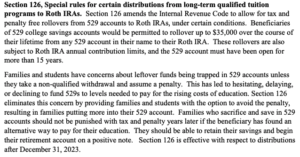Here’s how parents can use the 529 to Roth IRA rollover to their family’s advantage.
Beginning in 2024, you can convert money from a 529 college savings account to a Roth IRA held in the beneficiary’s name by doing a 529 to Roth IRA rollover. Thanks to new legislation passed in the SECURE 2.0 Act, you can do a 529 to Roth IRA rollover tax-free.
If you were reluctant to commit money to a 529 because you weren’t sure if your child would need it, this is a game-changer.
Prior to the new 529 to Roth IRA rollover rule, families faced taxes plus a 10% penalty to withdraw money for anything except qualified education expenses. Most tax-friendly workarounds involved keeping money in the 529 and changing the beneficiary. But this was only a logical solution if you had other family members who could use it.
The threat of a penalty plus tax felt like punishment for doing a good thing. Understandably so, it delayed or altogether deterred many families from using a 529 account for fear of being trapped. Until now!
How Does the 529 to Roth IRA Rollover Work?
A lifetime max of $35,000 can be converted per beneficiary.
Parents can rollover a lifetime max of $35,000 per beneficiary from a 529 to a Roth IRA. In addition to the $35,000 cumulative limit, 529 to Roth IRA rollovers are limited to $6,500 per year.
The annual limit aligns with the regular IRA contribution maximum that will adjust over time.
529 accounts must be 15-years old.
Only “seasoned” 529 accounts are eligible. To do a 529 to Roth IRA rollover, your 529 account must be opened for 15 years first. This 15-year waiting period is another incentive to open a 529 account for each of your children sooner rather than later, even if it’s with just a few bucks. The sooner you open your account, the sooner you get flexibility.
It’s also possible that changing beneficiaries could restart the 15-year clock, so hold off on making any unnecessary changes if a rollover could be in your 529 account’s future. (Experts are waiting for clarification on this one.)
Only money in the 529 account for over 5 years can be converted.
Money you contribute to or earn in a 529 account within the past 5 years is ineligible for the 529 to Roth IRA rollover, even if the account has been opened for 15 years. You can still do the rollover – just not with those fresh dollars.
This prevents parents from dumping $30,000 into a 529 account during their child’s senior year of college with the plan to immediately flip it to a Roth IRA via the rollover.
Converted money must remain in the Roth IRA for 5 years.
Once a 529 to Roth IRA rollover has been completed, you must let converted money remain in the Roth for at least 5 years. After 5 years pass, conversions are accessible by the beneficiary tax- and penalty-free.
Considering the beneficiary is probably young, hopefully this is money they can leave invested for the long haul. I’ll show you how this decision can positively impact their life below!
Rollovers are not subject to Roth IRA income limits.
529 to Roth IRA rollovers are not subject to the income limitations of Roth IRAs. In other words, you can do a 529 to Roth IRA rollover regardless of how much money your family earns.
The Roth IRA must be in the beneficiary’s name.
Finally, note that the 529 to Roth IRA rollover isn’t a way to reclaim money for your own retirement. Conversions can only be done into a Roth IRA in the beneficiary’s name, unless you want to pay the penalty and taxes.
This might seem like a lot of rules, but they’re actually quite easy to follow if you use the new law as intended. It was created to give families who diligently invested into 529 accounts an escape hatch free of penalties and taxes. The behavior the IRS and Treasury want to curb, which will inevitably happen, is overstuffing 529 to accounts to exploit a tax loophole.
Related Post: 3 Roth IRA Strategies to Grow Your Family’s Wealth
The Impact of $35,000 Tax-Free
Here’s what a 529 to Roth IRA rollover could look like. Let’s say you opened a 529 account for your child when they were young and regularly invested in it. By the time college rolls around, they have a sizable chunk of money to use. Upon college graduation, because of scholarships and prudent decisions, they have money left over.
Over the course of 6 years, you’d convert the cumulative $35,000 into a Roth IRA held in their name. In years 1 through 5, you’d roll $6,500 increments (or whatever the IRA limit is in the future). Then, in the final year, you’d roll the remaining $2,500.
- Year 1 Conversion = $6,500
- Year 2 Conversion = $6,500
- Year 3 Conversion = $6,500
- Year 4 Conversion = $6,500
- Year 5 Conversion = $6,500
- Year 6 Conversion = $2,500
- Total = $35,000
Assuming the beneficiary is 22 when conversions start and can earn a 7% return in the stock market, this money could compound to over $550,000 by the time they’re 65 years old.
$35,000 isn’t a huge amount of money, but because of the long time young adults can leave their investments compound in the market, you’re looking at a huge swing in their future finances. That’s the most exciting part of this new law!
Related Post: How to Make Compound Interest Work for You
Madi, Tell Me What to Do
If you don’t have a 529 account opened for each of your kids, put it at the top of your to-do list. Even if you can’t regularly contribute, open it and fund it with a few bucks to start your 15-year window. And because we don’t know yet if changing the beneficiary on a 529 resets the 15-year clock, be strategic about beneficiary swaps.
Otherwise, for now we wait. 529 to Roth IRA rollovers can begin in 2024 for mature accounts. If you have young children, there’s not much else to do in the meantime aside from saving for college.
As parents, we’re constantly allocating limited resources. That’s what makes committing money to a big expense way in the future feel scary. The new 529 to Roth IRA rollover rule makes this commitment easier to make.
I wouldn’t, however, pour every dollar into your children’s college savings if you haven’t secured your own retirement. Prioritize yourself.
One of the best gifts you can give your kids is your own financial stability. You can always gift money to them later in life from a taxable brokerage account.
Related Post: Invest for Retirement or My Kid’s College Tuition?
Resources:

SECURE 2.0 Act announcement summarizing the rule.
The opinions voiced in this material are for general information only and are not intended to provide specific advice or recommendations for any individual. To determine which investments may be appropriate for you, consult with your financial advisor.

